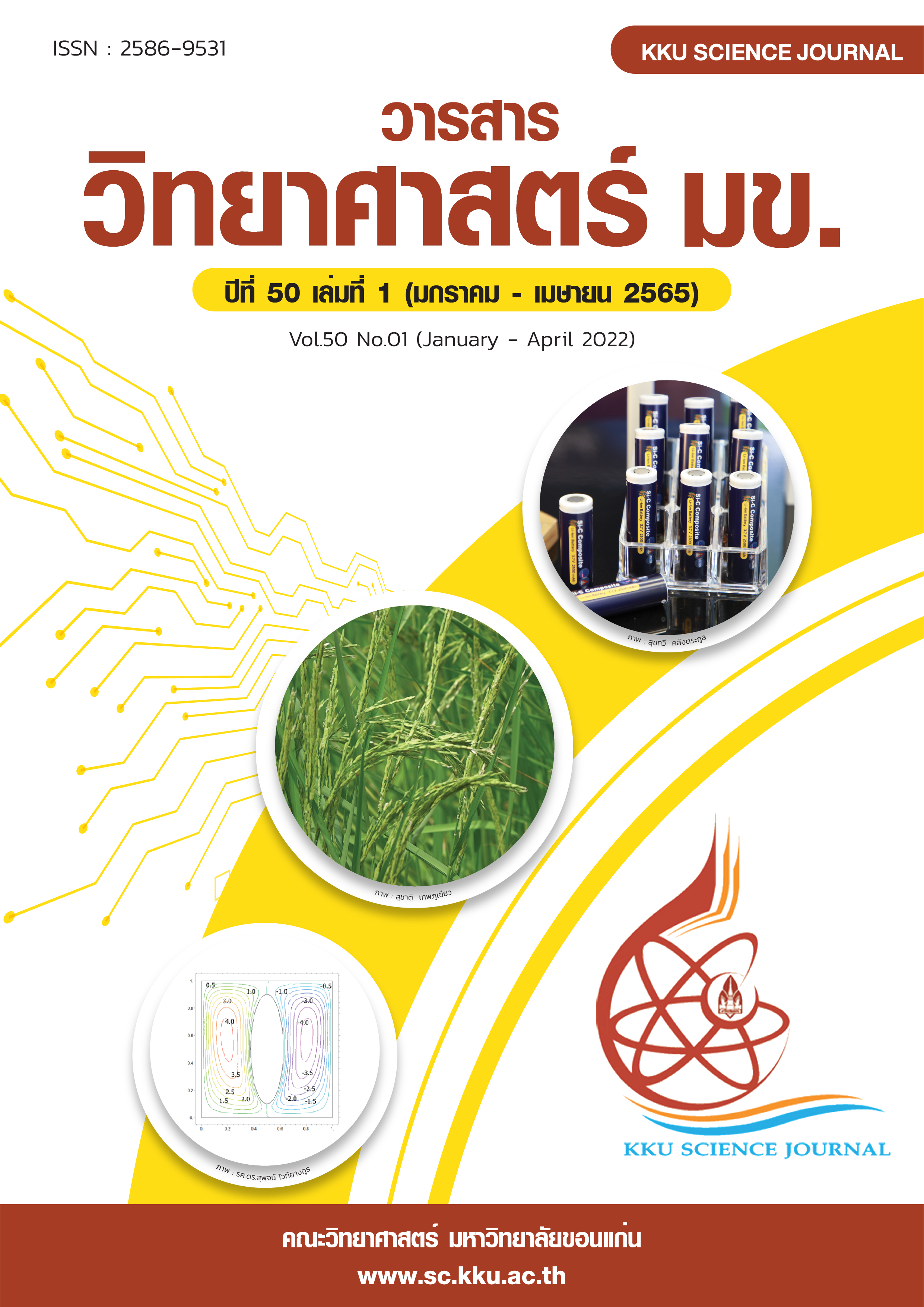Preparation of Epoxidized Soybean Oil for Use as Bio-based Epoxy for Coating Application
Main Article Content
Abstract
Epoxidized Soybean Oil (ESO) is widely used in industry such as lubricants and coatings because it is cheap and synthesized from plants that is renewable. The objective of this research is to prepare ESO and crosslinking agent (B) at xESO+yB by volume where x is the ratio of ESO and y is the ratio of B at 1ESO+0.5B, 1ESO+0.75B, 1ESO+1B, 1ESO+2B and 1ESO+3B. The blended materials were mixed in a beaker, stirred with a stirrer and poured into an 1x1x1 inch silicone mold, and then heated to 160, 175, 190 and 205 °C for 1, 3 and 5 hours. The samples were tested for their chemical structure, hardness and thermal properties. In the chemical structure test by FTIR technique. It was found that ESO showed the wave number of 827 cm-1, which was the peak of the epoxy group. In the hardness test, it was found that at 160 °C, all ratios did not solidity and the workpiece began to harden at 175 °C and the hardness increased at the temperature of 190 °C as 1ESO+1B gave a maximum average hardness of 99.75 HA. However, the hardness decreased when the temperature was increased to 205 °C, because at this temperature the materials might be degraded. In addition, according to the thermal properties test it was found that at the ratio of 1ESO+1B, had at the lowest endothermic temperature of 129.21 °C, which can be concluded that the 1ESO+1B was the optimal proportion for the applications. This ratio was used to coat wood to prevent water absorption and coat nails to prevent rust. It was found that the water absorption of wood reduced and nails did not have rust.
Article Details

This work is licensed under a Creative Commons Attribution-NonCommercial-NoDerivatives 4.0 International License.
References
พิมพ์ชนก ไสไทย, สุนันท์ จรเจนเกียรติ, วิชนิดา ชินผา และ วราภรณ์ ต้นรัตนกุล. (2550). การสังเคราะห์น้ำมันถั่วเหลืองอีพ็อกซิไดซ์. วารสารวิจัยและพัฒนา มจธ. (ฉบับพิเศษ): 583-589.
Basturk, E., Inan, T. and Gungor, A. (2013). Flame retardant UV-curable acrylated epoxidized soybean oil based organic-inorganic hybrid coating. Progress in Organic Coatings 76(6): 985-992.
Corcuera, M.A., Rueda, L., Fernandez, B., Marieta, C., Mondragon, I. and Eceiza, A. (2010). Microstructure and properties of poly urethanes derived from castor oil. Polymer degradation and stability 95(11): 2175-2184.
Galia, M., Espinosa, L.M., Rondo, J.C., Lligadas, G. and Cadiz, V. (2010). Vegetable oil-based thermosetting polymers. European journal of lipid science and technology 112(1): 87-96.
Gerbase, A.E., Petzhold, C.L. and Costa, A.P.O.J. (2002). Dynamic mechanical and thermal behavior of epoxy resins based on soybean oil. Journal of the American Oil Chemists' Society 79(8): 797-802.
Petrie, E. (2005). Epoxy Adhesive Formulations: Mc Graw-Hill Professional.
Situ, Y., Hu, J., Huang, H., Fu, H., Zeng, H. and Chen, H. (2007). Synthesis, Properties and Application of a Novel Epoxidized Soybean Oil-toughened Phenolic Resin. Chinese Journal of Chemical Engineering 15(3): 418-423.
Soo-Jin, P., Fan-Long, J. and Jea-Rock, L. (2004). Thermal and mechanical properties of tetra functional epoxy resin toughened with epoxidized soybean oil. Materials science and Engineering: A 374(1-2): 109-114.
Soontornchai, S., Lertwisuttipaiboon, S. and Tosing, P. (2016). Bioplastic from Agricultural crop to health and Environment. Journal of Health and Health management 3(1): 24-36.
Sudheer, K., Sushanta, K., Smita, M. and Sanjay, K. (2017). Recent Development of Biobased Epoxy Resins: A Review. Polymer-Plastics Technology and Engineering 57(3): 133-155.
Xia, Y. and Larock, R.C. (2010). Vegetable oil-based polymeric materials: synthesis, properties, and applications. Green Chemistry 12(11): 1893-1909.
Xujuan, H., Xinxin, Y., He, L., Shibin, S., Zhaosheng, C. and Kang, W. (2019). Bio-based thermosetting epoxy foams from epoxidized soybean oil and rosin with enhanced properties. Industrial Crops & Products 139(1): 1-9.
Yee, B., Rosnitam, A., Khalina, A., Nyuk, L., Roseliza, K. and Khairul, F. (2016). Comparative Study of Chemical Mechanical, Thermal and Barrier properties of Poly (Lactic Acid) Plasticized with Epoxidized soybean oil and Epoxidized Palm oil. Bio Resources 11(1): 1518-1540.


